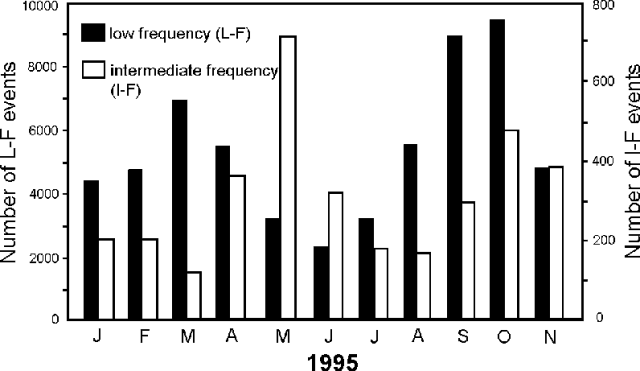Report on Poas (Costa Rica) — December 1995
Bulletin of the Global Volcanism Network, vol. 20, no. 11 (December 1995)
Managing Editor: Richard Wunderman.
Poas (Costa Rica) Fumarolic and seismic activity
Please cite this report as:
Global Volcanism Program, 1995. Report on Poas (Costa Rica) (Wunderman, R., ed.). Bulletin of the Global Volcanism Network, 20:11. Smithsonian Institution. https://doi.org/10.5479/si.GVP.BGVN199512-345040
Poas
Costa Rica
10.2°N, 84.233°W; summit elev. 2697 m
All times are local (unless otherwise noted)
The surface of the sky-blue crater lake rose in November (20 cm higher than October); the lake's temperature was 26°C. A vigorous subaqueous fumarole appeared adjacent the lake's S shore. The W-terrace fumarole emitted yellow, sulfur-rich gases and particles; other fumaroles located on the NW-SW terrace emitted only low amounts of gases. Measured fumarole temperatures were in the range 94-96°C along the S and SE crater, an area that produced 100-m-tall gas columns. Gases escaping the pyroclastic cone had temperatures of 93°C.
During 1-22 November the local seismic station recorded 5,146 events (predominantly of low-frequency), significantly fewer than the number seen in the two previous months (figure 59).
 |
Figure 59. Poás seismicity for January-November 1995 recorded at station POA2 (2.7 km SW of the active crater). Courtesy of OVSICORI-UNA. |
Geological Summary. The broad vegetated edifice of Poás, one of the most active volcanoes of Costa Rica, contains three craters along a N-S line. The frequently visited multi-hued summit crater lakes of the basaltic-to-dacitic volcano are easily accessible by vehicle from the nearby capital city of San José. A N-S-trending fissure cutting the complex stratovolcano extends to the lower N flank, where it has produced the Congo stratovolcano and several lake-filled maars. The southernmost of the two summit crater lakes, Botos, last erupted about 7,500 years ago. The more prominent geothermally heated northern lake, Laguna Caliente, is one of the world's most acidic natural lakes, with a pH of near zero. It has been the site of frequent phreatic and phreatomagmatic eruptions since an eruption was reported in 1828. Eruptions often include geyser-like ejections of crater-lake water.
Information Contacts: E. Fernandez, E. Duarte, R. Saenz, W. Jimenez, and V. Barboza, Observatorio Vulcanologico y Sismologico de Costa Rica, Universidad Nacional (OVSICORI-UNA).

